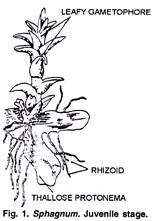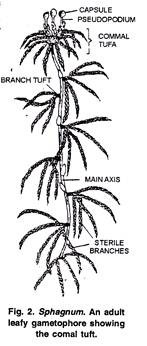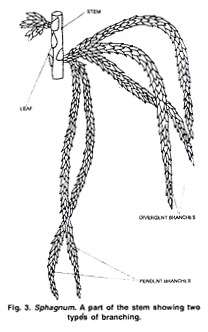In this article we will discuss about Sphagnum. After reading this article we will learn about:- 1. Habit and Habitat of Sphagnum 2. Gametophytic Phase of Sphagnum 3. Internal Structure of Sphagnum 4. Reproduction 5. Fertilization 6. Affinities 7. Special Features.
Contents
Habit and Habitat of Sphagnum:
Sphagnum is represented by about 336 species which are cosmopolitan in distribution. In India, it is represented by about 20 species in Himalayas. These species are aquatic or semiaquatic and grow in dense masses or cushions in swamps, ponds and lake margins, moist heaths and wet hill sides.
Gametophytic Phase of Sphagnum:
External Features of Sphagnum:
Plant body is gametophytic and consists of two stages:
Juvenile stage and leafy gametophore Juvenile stage: It is also called protonema and is formed by the germination of the spores. It is irregularly lobed thallus like structure and one cell in thickness. It is attached to the substratum by multicellular rhizoids with oblique septa. From the protonema arises the erect leafy gametophyte called the gametophore (Fig. 1).
Leafy Gametophore:
It represents the adult form. The adult gametophyte (gametophore) is perennial and can be differentiated into axis or ‘stem’ and ‘leaves’.
Stem:
It is erect and may be a foot or more in length with a diameter up to 1.2 mm. The stem is well branched, the branching being usually lateral. Near the apex of the stem the branches are short and of limited growth and are clustered together closely to form a compact head called Comal tuft or coma (Fig. 2). The coma formation occurs due to the presence of very short internodes at the apex of the stem.
Lower down on the stem are borne additional elongated branches. They occur usually in tufts of 3-8 (commonly five) in the axil of every fourth leaf on the main stem. These branches are of two types (fig 3).
(a) Divergent branches:
These branches grow out laterally from the stem and extend outward in a horizontal position.
(b) Drooping or Flaogelliforms branches:
These branches grow out laterally from the stem; droop or hang or run very close to the stem. These pendent or de-current branches act as water conductors.
‘Leaf’:
Leaves are borne on the main stem as well as on the branches. On the stem they are little apart while on the branches they are overlapping. Leaves are arranged in a spiral manner with a phyllotaxy of 2/5 i.e., sixth leaf will come above the first leaf. They are thin, small, fleshy, oblong with a broad base. The margin is entire with acute apex.
Mid rib is lacking. If seen in surface view the leaf consists of meshes composed of two different types of cells: small living photosynthetic cells containing chlorophyll and large, hyaline rhomboidal cells. (Fig. 4A). These cells are provided with small pores. These pores are rounded in shape and mainly concerned with intake of water.
Spiral thickenings are also present in the cells (Fig. 4B). These thickenings compensates the absence of mechanical’ issue. The leaves on the branches are smaller in size than stem. These leave are compactly arranged in the imbricate fashion.
Internal Structure of Sphagnum:
Axis or ‘Stem’:
The transverse section of axis can be differentiated into 3 distinct zones:
(i) Cortex or hyaloderm
(ii) Prosenchymatous region or hadrome
(iii) Central cylinder or Medulla.
(i) Cortex:
It is the outermost region of the axis. Its cells are small and form compact tissue. In young axis, the cortex is only one cell thick. In S. subsecundum it is single layered throughout its life but in majority of species it is composed of many layers. In S. recurvum, S. obtusum, it is composed of two to three layers of hyaline cells.
In S. acutifolium, S. squarrosum it is composed of two to five layers of cells (Fig. 5). In S. palustre, these cortical cells develop spiral thickenings and large oval perforations on their walls. In branches the cortical cells remain one cell thick. Cortical cells store water. These cells absorb water by capillary action and thus compensates for the absence of rhizoids in the adult gametophytic plant.
In some species of Sphagnum for e.g., S. molluscum, S. tenellum, some cortical cells elongate to form a long curved structure with a curved neck and an opening. These modified cells resemble a retort hence; these cells are called ‘retort cells’ (Fig. 6A, B). There cells are inhabited by small microscopic animals. These cells are absent in those species in which the thickenings and pores are present in the cortical cells.
(ii) Prosenchymatous region:
Cortex is followed by a cylinder of narrow, thick-walled elongated cells. It is 4-6 layered and surrounds the medulla (Fig. 5). It gives the mechanical support to the axis’ tissue.
(iii) Medulla or Axial Cylinder:
It is composed of thin walled, colourless, parenchymatous cells (fig 5). It is like the pith of the higher plants and functions as storage region.
‘Leaf’:
Transverse section (T.S.) of leaf shows that it is one cell thick. In young leaves the cells are rectangular, and are of same size.
However, in mature leaves the T.S. appears as beaded or moniliform due to the presence of two types of cells large, hyaline or capillary cells and the small, green assimilatory or Photosynthetic cells., The two kind of cells regularly alternate with each other. S. acutifolium the hyaline cells bulge towards the underside of the leaf and the green cells arc triangular. The base of the triangle is directed upwards (Fig. 7A).
In S. tenellum both types of cells are just reverse to this (Fig. 7B). In S. squarrosum the green cells are hemmed in, above and below, by the hyaline cells, and may appear spindle-shaped in transverse-section. Their ends reach neither the upper nor the lower surface of the leaf (Fig. 7C). Hyaline cells are dead and filled with water while assimilatory Fig. 7 cells are alive and photosynthetic in function.
Reproduction in Sphagnum:
Sphagnum reproduces by vegetative and sexual methods.
Vegetative Reproduction: It takes place by the following methods:
Innovation:
It is the common method of reproduction. It takes place by the formation of special vegetative branches known as innovations. Occasionally one of the branches in the axillary cluster become robust and grows upwards. This branch shows all the characteristics of main axis and known as innovation. Each innovation develop into a new plant when detatch from the parent plant.
Multiplication of Protonemal Branches:
Any marginal cell of the primary protonema may become meristematic and forms a green cellular filament. In apical portion grows into flat, thallus-like green secondary protonema. Marginal cells of secondary protonema form the leafy gametophore.
Regeneration:
The growth of new tissues or organs to replace those lost or damaged in injury is known as regeneration. Sphagnum has great power of regeneration.
During dessication, the growth of the Sphagnum is checked because the physiological activities like respiration and photosynthesis are suspended, but the cytoplasm shows a high degree of resistance to dessication. When water is available these activities are resumed and normal growth of the plant takes place. Such plants are known as pallacuophytes (Buch, 1947).
Sexual Reproduction in Sphagnum:
Sexual reproduction is oogamous. It takes place by the formation of male and female reproductive organs which develop on special branches. Sphagnum may be monoecious or dioecious. Monoecious species are protandrous.
The Antheridium:
The antheridia or the male sex organs develop on the catkin like short lateral branches known as the antheridial or male branches (Fig. 8A). These branches develop near the apex of the main shoot of the plant. These branches bear the leaves which are just like the foliage leaves but in comparison they are shorter (fig. 8. A).
These leaves are brightly coloured (commonly yellow, purple, brown, bright red or dark green). In the axil of each leaf solitary antheridium develops (antheridsia occur alternately arranged with the leaves) (Fig. 9). A mature antheridium consists a long stalk and a globular body.
The stalk may be as long as the body of the antheridium. It consists of the two to four rows of cells which are 8-10 cells in length. The antheridial body is covered by a single layered sterile jacket which encloses many androcytes. Each androcyte metamorphosis into a spirally coiled biflagellate antherozoid.
When the antheridium is mature, the apical cells of the jacket absorb water, swell and undergo irregular separations which turn backwards. The antherozoids are liberated and swim in water (Fig. 10).
The Archegonium:
One to five archegonia develop at the tip of the short archegonial branches (Fig. 9A). The leaves of the archegonial branches are green and much larger than the vegetative branches. These leaves are called perichaetium (Fig. 11 A). These leaves protect the archegonia, young sporophytes and provide food to the developing sporophytes.
The archegonia which develop directly from the apical cell of the archegonial branch are known as the primary archegonia while the remaining one are known as secondary archegonia. A nature archegonium is long and stalked structure possessing venter and a long neck enclosing 8 or 9 neck canal cells, a venter canal cell and an egg cell (Fig. 11B).
Fertilization in Sphagnum:
The process of fertilization is identical with other bryophytes. Water is essential for fertilization.
At the time of fertilization the neck canal cells along with the venter canal cell disintegrate to form a clear passage for the antherozoids. They enter through the cover cells and reach up to the egg, but only one fuses with the egg to form the zygote. In S. subsecundum the venter canal cell is persistent and fuses with the egg cell to form zygote.
The Sporophyte:
The sporogonium develops from only one archegonium. The other archegonium, however, may also persist for some time. The mature sporogonium is differentiated into foot and capsule. Both are connected by a short, narrow neck like constriction which represents the suppressed seta, sporogonium is elevated on a short cylindrical, leafless stalk, the pseudopodium (Fig. 12A).
The pseudopodium is gametophytic and it is formed by the post fertilization intercalary growth of the axis of the archegonial branch.
The pseudopodium together with the basal portion of the calyptra forms a sac-like structure, the vaginula which encloses the foot. The main functions of the pseudopodium are to elevate the capsule for above the perichaetial leaves, to compensate the suppression of seta and to help in the dispersal of spores.
Foot:
It is bulbous and made up of parenchymatous cells. The main function is to absorb the food material for the developing sporophyte.
Capsule:
It is spherical and dark brown in colour. It contains central columella which is over arched by a done shaped spore sac containing haploid spores (Fig. 12A). The wall of the capsule is 4-6 layers thick. The outer layer of the capsule wall is called epidermis. The cells of the epidermis are compactly arranged and contain chloroplasts.
It has many non-functional and rudimentary stomata. In young sporogonium, a circular, convex disc is present at the top of the capsule. It is called operculum. It is separated from the rest of the capsule region by a circular (ring like) groove of thin walled cells called annulus.
Dispersal of spores or Dehiscence of capsule:
On sunny days the columella of mature capsule dries up, breaks down and forms a large air cavity below the air sac. Air enters in this cavity through the rudimentary stomata.
The wall of the capsule dries up under the influence of the sun and spherical form of the capsule gradually becomes cylindrical (Fig. 13 A, B). The imprisoned air in the capsule is compressed and held under considerable pressure due to change in the shape of the capsule.
The operculum also dries and shrinks. Due to this a little difference in the tension is thus set up. It puts a strain on the thin celled annulus cells which finally rupture under the mounting pressure of imprisoned air. The operculum is blown off with explosive force.
The pressure of imprisoned air also ruptures the spore sac and the cloud of yellow or orange coloured spores is blown to a height of several centimeters in the atmosphere (Fig. 13 C, D). The method of spore discharge is, therefore, known as the air gun or explosive mechanism.
Structure and Germination of Spore:
Each spore is uninucteare, triangular to spherical and has two layered wall with a triradiate mark (Fig. 14A, B). The outer wall is omanemted and known as exine while the inner wall is smooth and known as intine. The spores remain viable for few months and germinate under favourable conditions. Spores absorb water and swell up.
Exine ruptures and intine comes out in the form of a germ tube. The germ tube divides transversely to form 2-4 celled green filaments (Fig. 14C-E). The terminal cell of the filament develops two cutting faces. It cuts segments alternately on the right and left anal forms green, single cell thick plate like structure.
It is called primary protonema (Fig. 14F-J). The apical cell loses in activity and some marginal cells of the plate like protonema become active and form secondary protonema with rhizoids and leaf buds. These buds gradually develop into leafy gametophores (fig. 14 K,L).
Affinities of Sphagnum:
Sphagnum shows resemblance with liverworts (Hepaticopsida), hornworts (Anthocerotopsida) and mosses. However, it possess certain characters in which it stands apart from all the three.
These are:
Resemblance with Hepaticopsida:
(a) Thalloid protonema resemble the juvenile stage of some acrogynous Jungermanniales.
(b) Position, structure and dehiscence of antheridium is like jungermanniales (e.g. Porella)
(c) Position origin and development of archegonium is similar to that of acrogynous Jungermanniales.
These resemblances between the liverworts and Sphagnum point to the its intermediate position between the liverworts and mosses.
Resemblance with Anthocerotopsida:
(a) Absence of apical growth in the young sporogonium.
(b) Development of archesporium from the amphithecium which overarch the columella.
(c) Development of entire endothecium into columella.
(d) Capsule wall possess chloroplast and rudimentary stomata.
(e) Sporogonium is differentiated into bulbous foot, and constriction like seta.
Resemblance with Mosses:
1. Presence of erect, leafy gametophore.
2. Multicellular, branched rhizoids with oblique septa.
3. Apical growth of stem, leaves and antheridia.
4. Archegonium having massive stalk and venter.
5. Absence of elaters.
6. Dehiscence of capsule by operculum.
Special Features of Sphagnum:
1. Absence of rhizoids in adult leafy gametophore.
2. Branches arise in tufts from the axil of every fourth leaf.
3. Absence of mid rib in the leaves.
4. Stem and leaves show unique structures. Cortex in the old stem is spongy and sometimes develops spiral thicknings. Single layered leaf consists two types of cells: large hyaline cells and small green photosynthetic cells.
5. Presence of hyaline retort cells.
6. The water in which it grows is highly acidic. It is due to the presence of some organic substance of a colloidal nature in the cell walls.
Above resemblance of Sphagnum with Hepaticopsida, Anthocerotopsida and Bryopsida suggest that Sphagnidae may be synthetic group.















